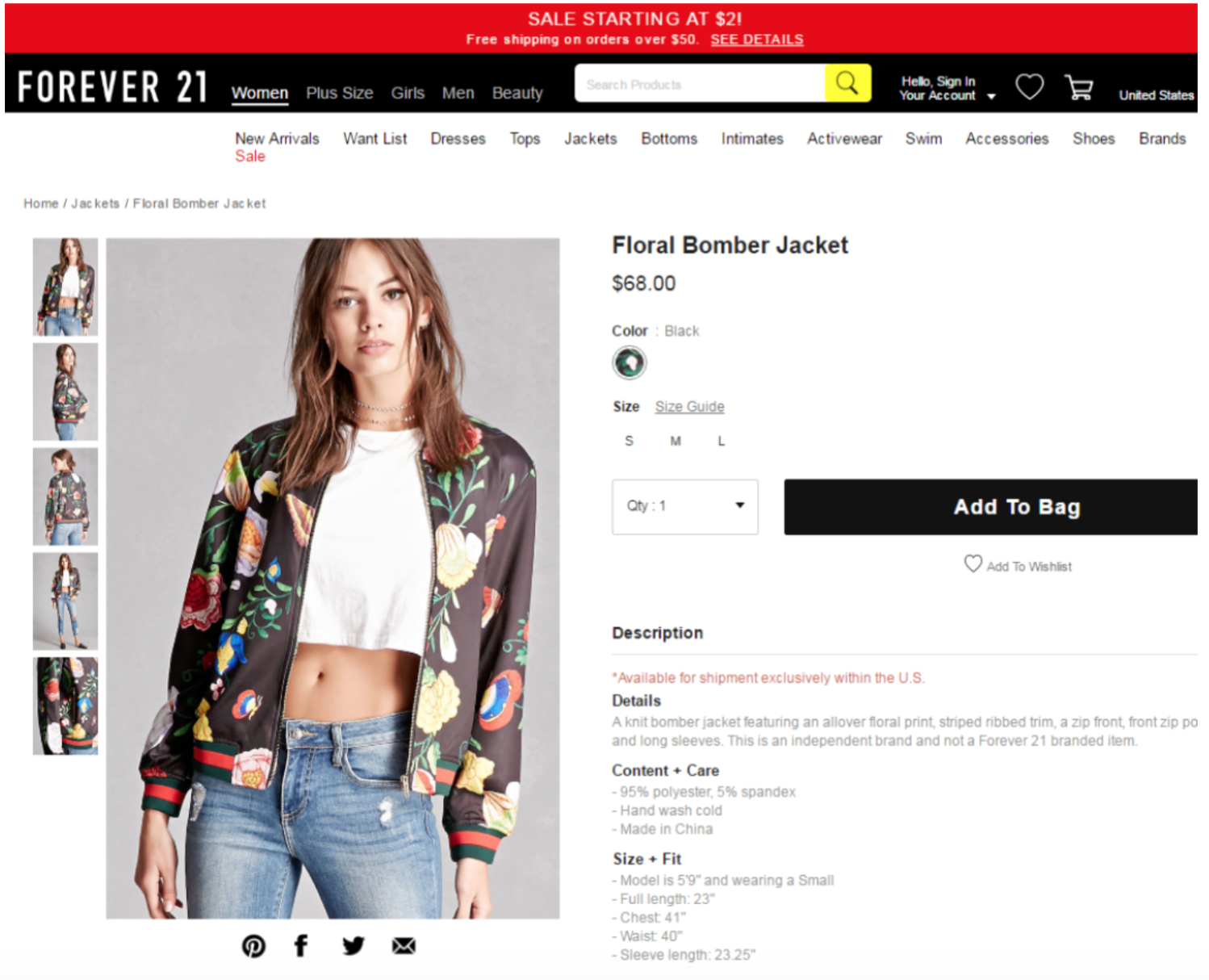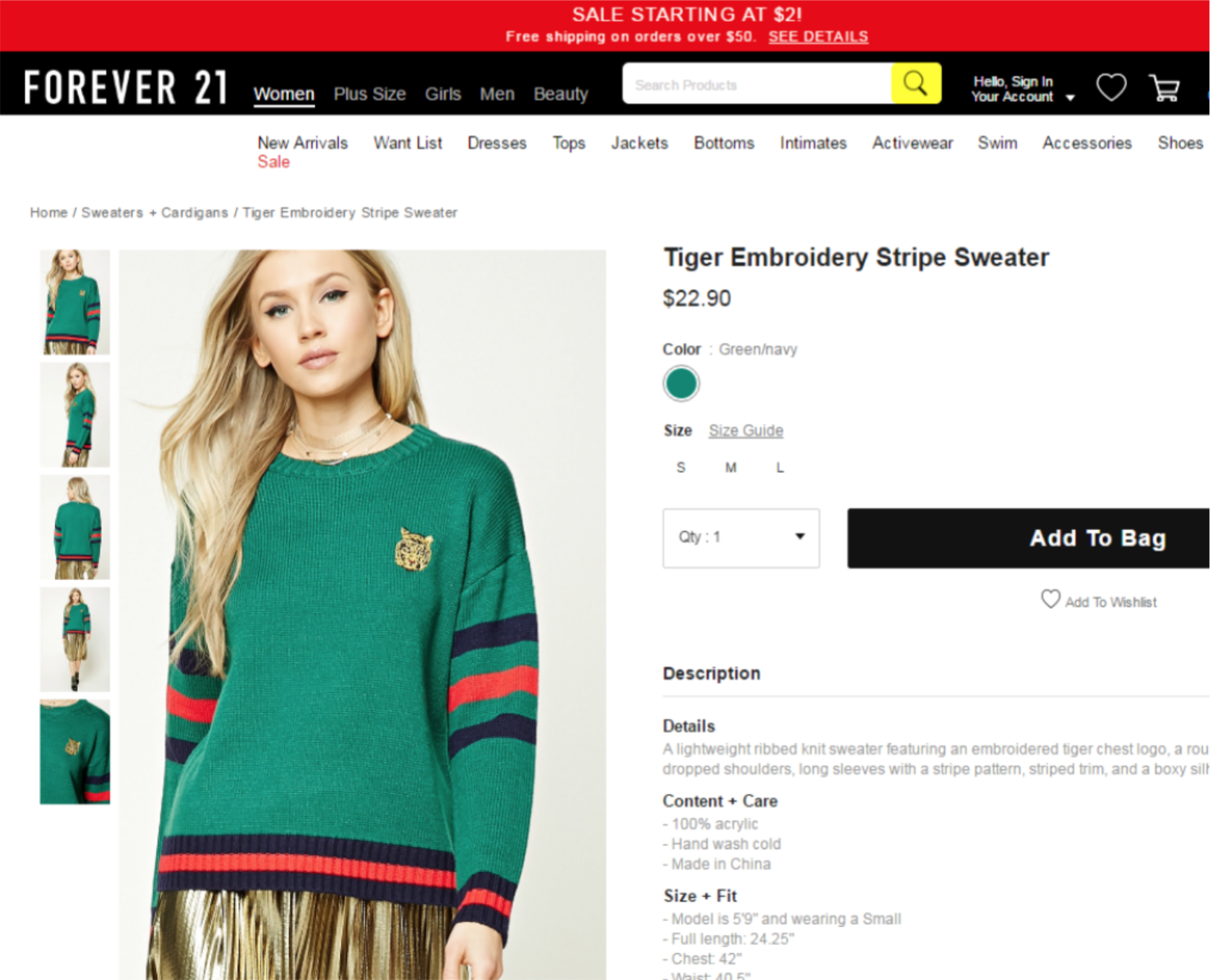
One of the allegedly infringing Forever 21 designs
After being hit with a strongly worded lawsuit from Forever 21 in June over the fast fashion giant’s use of its blue-red-blue and green-red-green stripe motifs, Gucci has asked the U.S. District Court for the Central District of California to dismiss the case. In case the court opts not to, Gucci has filed a counterclaim against Forever 21 for “willful trademark infringement, trademark dilution and unfair competition.”
According to Forever 21’s complaint, in which the retailer calls itself an “American success story,” Gucci first sent Forever 21 a cease and desist letter in December 2016, in which Gucci demanded that Forever 21 cease all sales of garments and accessories bearing blue-red-blue and green-red-green stripes – as Gucci maintains federal trademark protection for those specific stripe combinations (and has for some time now, with registrations dating back to 1988).
The initial letter was followed by two more letters from Gucci in January and February 2017, respectively, threatening to file suit if Forever 21 did not remove the garments and accessories at issue, namely, three bomber jackets, one sweater, and a choker necklace, from its stores and e-commerce websites.
Forever 21 followed up by filing a declaratory judgment action against Gucci, asking a federal court in California to declare that its garments are not infringing Gucci’s striped marks, and as a result, Gucci does not have a case for trademark infringement.
(For the uninitiated, a declaratory judgment is a binding judgment from a court defining the legal relationship between parties and their rights in the matter before the court. It asserts the court’s authoritative opinion regarding the exact nature of the legal matter without requiring the parties to do anything).
And in case that is not enough, Forever 21’s lawsuit calls for the Gucci trademark registrations at issue (at least nine different trademark registrations) to be cancelled and any pending applications for related marks to be terminated.
Forever 21 alleges in its lawsuit, “Many clothing and accessory items adorned with decorative stripes colored blue-red-blue or green-red-green are sold by countless third parties … The colors red, blue, and green, and stripe designs, are among the most favorite, popular and widely used colors and design features on clothing.”
With that in mind, it states that “Gucci should not be allowed to claim that Gucci, alone, has a monopoly on all blue-red-blue and green-red-green striped clothing and accessory items.”
Gucci’s Response
In its response to Forever 21’s suit, which Gucci has called a “legal assault” against its brand “built on undermining the very notion of trademark protection,” the Italian design house stated, “In stark contrast to the Gucci brand’s reputation for innovation in design and high-end fashion, Forever 21 has built its business on imitation.”
Gucci states in its answer (the legal term for their response to the lawsuit initiated against them) that the fast fashion giant is “brazenly” masquerading as a “victim of unfair competition in search of legal redress in the courts,” and that it is “bringing suit to cancel some of the most famous marks in the fashion world” and “profiting handsomely by flaunting the law.”
Additionally, Gucci sets forth, “Despite Forever 21’s attempt to use its lawsuit to intimidate Gucci into ceasing its trademark enforcement efforts, Gucci is as committed as ever to protecting its long established intellectual property rights, which are at the heart of the brand’s identity, and to ending once and for all Forever 21’s reprehensible exploitation of its distinctive trademarks and those of other brands who have suffered the same type of piracy,” Gucci’s statement continues.
“Gucci considers the defense and enforcement of its celebrated trademarks of paramount importance in protecting its customers from those who wish to knowingly profit from deception and confusion.”

One of the allegedly infringing Forever 21 designs
Still yet, “Gucci America is standing up again to assert its commitment to its customers that it will protect the value and quality of Gucci products, and that it will not allow infringements of, or attacks on, its signature trademarks.”
(Note: Trademark infringement occurs when one party uses the trademark of another (or one that is similar) in connection with the sale of goods or services. The key inquiry in a trademark infringement action is whether consumers are likely to be confused by the allegedly infringing use. As a result, to amount to trademark infringement, the mark must be used in a manner that is likely to cause confusion, deception, or mistake about the source of the goods and/or services).
In addition to counter-suing for trademark infringement, Gucci has lodged a claim of trademark dilution, which is a cause of action separate from trademark infringement that recognizes the potential injury to a trademark holder in cases where there is not a likelihood of confusion. Unlike a trademark infringement claim, which requires the plaintiff (Gucci here) to show a likelihood of confusion, for dilution, a plaintiff need only show that the defendant’s mark is likely to cause dilution of plaintiff’s mark.
A spokesman for Gucci said of the counterclaims and call for dismissal, “Gucci has today taken steps to finally put an end to U.S. mass retailer Forever 21’s blatant exploitation of Gucci’s famous and iconic blue-red-blue and green-red-green stripe webbing trademarks.”
As for who will come out on top in the case, it is difficult to say. While trademark rights, themselves, tend to be somewhat straightforward, whether or not the average consumer is likely to be confused about the source of the allegedly infringing Gucci trademarks (consumer confusion is the key inquiry in a trademark infringement matter) is decided on a case by case basis. As such, it is difficult to say at the outset whether the average consumer (a standard that is distinct from the average fashion fan) could be misled as to the source of the Forever 21 items bearing the allegedly infringing Gucci trademarks.
What this case does, in fact, emphasize regardless of the outcome: The significant role that trademark law enjoys in fashion – and in other brand-centric industries, oftentimes playing a more noteworthy role than the actual designs, themselves. As you may have noticed, the lawsuit at hand does not take issue with copied garments or accessories. Instead, it focuses exclusively on the use of the Gucci trademarks and the value that the Gucci trademarks entail for the brand when included in the design of a garment or accessory.
This is indicative of the fact that many times, it is the presence of a brand’s trademarks that garners the most value and that consumers are actually paying for. The design, more often than not, is somewhat secondary, which is exactly why brands spend exorbitant amounts of resources policing unauthorizes uses of their marks, as Gucci is doing in the case at hand.







